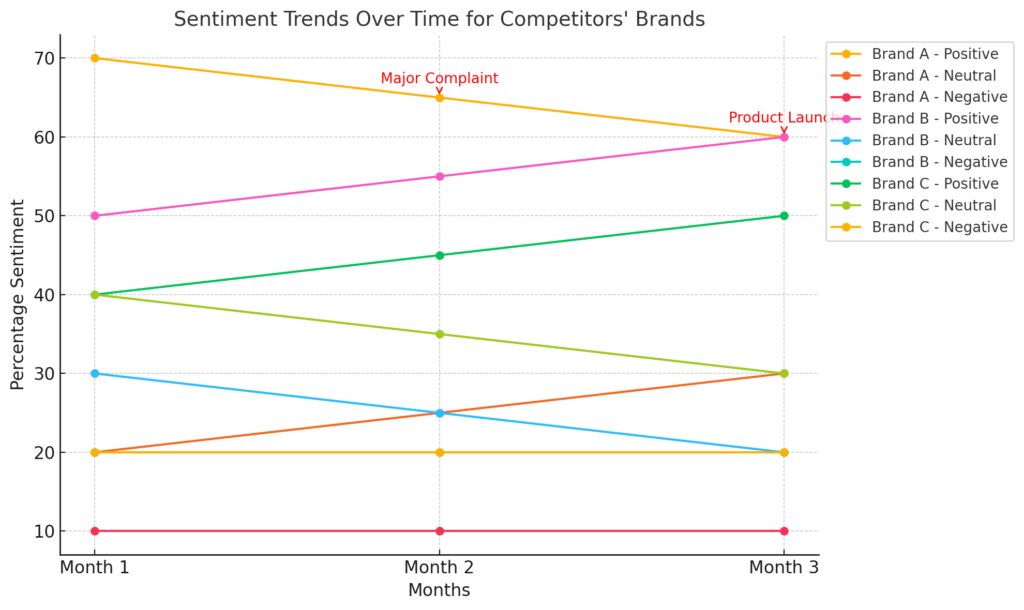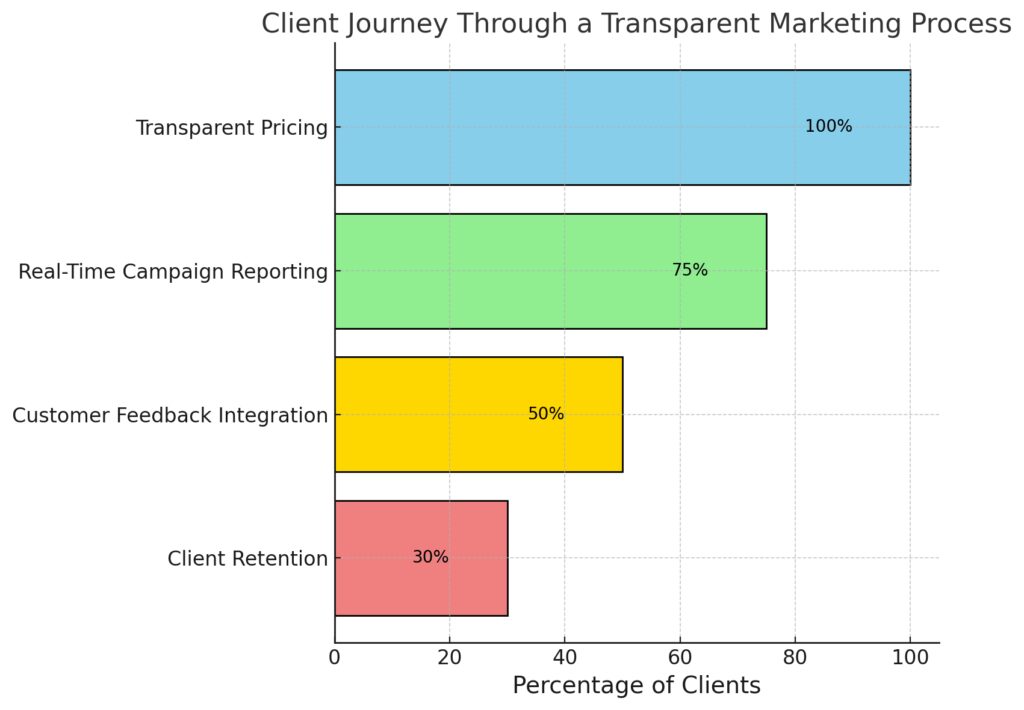
Why Understanding Competitor Weaknesses Matters
Building a Competitive Advantage
Analyzing your competitors is the first step to staying ahead. By identifying weaknesses, you can position your brand as a better choice. AI tools make this easier than ever, offering insights beyond what traditional methods can uncover.
Spotting Market Opportunities
Competitor weaknesses often reveal unmet customer needs or overlooked areas in the market. Imagine finding a gap that no one else has noticed—AI gives you that edge. These insights help you carve out unique value propositions.
Improving Customer Retention
When you understand where competitors fail, you can address those issues proactively. That’s how you build trust with your customers. AI can help you fine-tune your messaging, ensuring it resonates deeply with your audience.
How AI Simplifies Competitor Analysis
Automation in Data Collection
Gone are the days of manually scouring websites or reviews. AI tools, like Semrush and Ahrefs, can scrape competitor data, analyze patterns, and deliver actionable insights. This lets you focus on strategy, not grunt work.
Real-Time Insights
AI-powered platforms can provide real-time updates on competitor activities. Whether they’re launching a new product or receiving negative feedback, you’ll know instantly. This agility lets you respond before they can recover.
Advanced Predictive Analytics
AI doesn’t just analyze what’s happening now; it predicts future trends. For example, by identifying customer complaints in reviews, you can anticipate and address those needs before your competitors do.
Identifying Competitor Weaknesses with AI
Analyzing Online Reviews
AI tools can scan thousands of customer reviews in seconds. They identify recurring complaints, such as poor customer service or product flaws, giving you insight into where competitors are struggling.

Monitoring Social Media Sentiment
Social listening tools powered by AI, like Brandwatch or Hootsuite Insights, highlight negative sentiment trends about your competitors. These trends reveal what customers dislike, giving you a roadmap to do better.

Positive: Trends in customer appreciation.
Neutral: Stable or indifferent customer views.
Negative: Customer dissatisfaction.
Competitor Brands:
Brand A: Notable dip in positive sentiment in “Month 2” due to a major complaint.
Brand B: Positive sentiment spikes in “Month 3” following a product launch.
Annotations:
Key events such as complaints and product launches are annotated to correlate trends with real-world impacts.
Auditing Content Strategies
Competitor blogs and content often hide clues about their weak points. AI can analyze their topics, keywords, and engagement levels. It might reveal they’re missing valuable SEO opportunities—ones you can capitalize on.

Tapping into Customer Pain Points
Using AI-Driven Surveys
Customer surveys are gold mines of information. AI can analyze responses to identify pain points that competitors fail to address. For example, poor shipping times or lack of eco-friendly options.
Leveraging Sentiment Analysis
Advanced AI tools assess tone and emotions in customer feedback. Are people frustrated by competitors’ return policies? Use this knowledge to design a seamless, frustration-free process in your own business.
Identifying Service Gaps
AI maps common service complaints, like slow response times or inadequate technical support. If competitors are struggling here, you can swoop in and win over dissatisfied customers.

Tools to Pinpoint Market Gaps
AI-Powered Competitive Research Platforms
Platforms like SEMrush, Ahrefs, and SimilarWeb excel at uncovering where competitors fall short. They analyze keyword rankings, backlinks, and traffic sources, helping you find gaps in content marketing or SEO strategies.
For example, if your competitors rank poorly for certain long-tail keywords, you can create high-value content targeting those terms. This approach positions your brand as a go-to resource while bypassing the noise.
Predictive Demand Tools
Tools like Google Trends and AI-based analytics platforms predict market trends. If a competitor overlooks an emerging demand, like sustainable packaging or voice-activated tech, you can act on it early.
Incorporating these features into your offerings lets you claim the spotlight, satisfying unmet consumer needs.
CRM and Social Media Insights
Customer Relationship Management (CRM) systems with AI capabilities, like Salesforce or HubSpot, provide insights into unresolved customer pain points. Coupled with social media analytics, you can uncover areas where competitors fall short, such as poor communication or engagement.
This enables you to refine your own customer journey for better satisfaction and loyalty.
Building Solutions Around Competitor Weaknesses
Developing Superior Products
Once you’ve identified product flaws through AI insights, you can engineer better solutions. For example, if competitors face complaints about durability, use higher-quality materials to position your product as the more reliable choice.
AI tools like Autodesk Fusion can also simulate product performance, helping you design items that solve common problems.
Refining Customer Support
If competitors struggle with slow or unhelpful support, invest in AI chatbots and 24/7 service solutions. Tools like Drift or Intercom offer automated yet personalized support, addressing inquiries faster and better than traditional methods.
Over time, this builds a reputation for exceptional service that turns dissatisfied competitor customers into loyal advocates for your brand.
Creating Niche Marketing Campaigns
AI helps craft campaigns that emphasize your strengths against competitors’ weaknesses. For instance, if your competitor has confusing pricing, launch ads focusing on your transparent, no-hidden-fee approach.
Personalized campaigns that address these issues can convert leads who feel disenchanted by other brands.
Real-Life Success Stories Using AI

How Netflix Outmaneuvered Cable
Netflix used AI to identify where traditional cable providers were failing: high costs, rigid schedules, and lack of personalization. By leveraging data-driven insights, they delivered tailored recommendations and flexible viewing options, revolutionizing the entertainment industry.
Shopify’s E-Commerce Revolution
Shopify capitalized on e-commerce giants’ inability to support small businesses effectively. Through AI insights, they streamlined the setup process, integrating tools like payment gateways and marketing analytics. This attracted thousands of small business owners worldwide.
Amazon’s Data-Driven Domination
Amazon’s AI systems revealed weak points in competitors’ supply chains and pricing models. Their Prime shipping model addressed those gaps, transforming customer expectations for speed and reliability.
Identifying Potential Opportunities for Differentiation
Targeting Underserved Audiences
One of the most impactful ways to differentiate is by focusing on neglected customer segments. AI tools like Tableau or Google Analytics can identify demographic gaps in your competitors’ customer base.
For example:
- Are competitors ignoring younger audiences or older consumers?
- Is there a lack of inclusive products for diverse needs?
Once you identify these gaps, tailor your offerings to meet their needs. Personalization is key here—AI-driven insights can help you craft messages and products that resonate with these untapped groups.

Emphasizing Sustainable Practices
Sustainability is more than a trend; it’s an expectation. Many competitors might overlook eco-conscious initiatives due to cost or complexity. AI tools like IBM’s Environmental Intelligence Suite analyze environmental data and suggest actionable steps for greener operations.
Highlighting eco-friendly practices—like using sustainable materials or reducing carbon footprints—can attract environmentally conscious customers and position you as a responsible market leader.
Offering Customization Options
Competitors often rely on one-size-fits-all solutions. This presents an opportunity to differentiate by offering customization. AI platforms like Zoovu or Configurators can streamline this process by helping customers design their ideal products or services.
For example, customizable features in clothing, tech, or even payment plans can dramatically increase customer satisfaction. People love products that feel unique to them!
Building Transparent Processes
Transparency builds trust, and many competitors fail to deliver this. Use AI tools to create clear, accessible processes:
- Pricing transparency (no hidden fees).
- Detailed product information (e.g., sourcing, quality checks).
- Real-time order tracking (using AI-powered logistics like ShipStation).
Highlighting these efforts in your marketing not only differentiates your brand but also appeals to customers frustrated by opaque competitor practices.
Delivering Superior User Experiences
User experience (UX) is often where competitors fall flat. If their websites are clunky, apps are slow, or customer journeys are disjointed, this is your chance to shine.
- Use AI-driven UX tools like Hotjar to improve website navigation.
- Implement AI chatbots for instant, helpful responses.
- Optimize checkout flows to reduce abandoned carts.
By addressing these areas, you can create a seamless, enjoyable experience that outshines your competition.
Crafting a Differentiation Plan Tailored to Your Business
Step 1: Analyze Competitor Performance with AI
Start by using AI tools to deeply understand your competitors’ weaknesses. Here’s how:
- Content Gaps: Tools like BuzzSumo or Ahrefs can highlight underperforming or missing topics in competitors’ content strategies. Use this insight to create valuable, targeted material.
- SEO Opportunities: Platforms like SEMrush can identify poorly optimized keywords. For instance, if your competitor ranks low for “sustainable skincare,” craft content or campaigns targeting that term.
- Customer Feedback Mining: AI-powered sentiment tools like Lexalytics analyze competitor reviews and social media mentions. This reveals pain points such as poor product quality or delayed shipping.
Step 2: Position Your Brand Around Unique Strengths
Once weaknesses are clear, build a plan to emphasize your unique value propositions (UVPs):
- Be the Problem-Solver: If competitors fall short on customer support, train an AI chatbot (like Intercom) to offer immediate assistance and elevate satisfaction.
- Highlight Differentiation: Make your standout features the focus of marketing. Use AI like Phrasee to write email or ad copy that emphasizes your better, unique solutions.
Step 3: Personalize Offerings with AI
Customization can make your products or services stand out. Use AI-driven personalization tools like:
- Dynamic Yield: Adjust recommendations or promotions based on customer behavior.
- Zoovu: Offer interactive product configurations or buying guides tailored to individual preferences.
Example: If your competitors offer standard travel packages, differentiate by allowing customers to build bespoke itineraries with AI-guided options.
Step 4: Monitor Emerging Trends
Use predictive tools to stay ahead of market shifts:
- Google Trends: Spot rising interest in niche topics before your competitors.
- Crimson Hexagon: Monitor social trends to understand how customer expectations are evolving.
If you notice an uptick in demand for hybrid remote work software, consider developing tools that bridge those gaps before the competition.
Step 5: Foster Customer Trust and Loyalty
Build on areas where competitors under-deliver by being a brand people trust:
- Transparent AI Solutions: Use customer-data-powered insights, like via HubSpot, to create transparent pricing and personalized follow-ups.
- Ethical AI Practices: Highlight responsible data use to build credibility, especially in industries where privacy concerns dominate.
Sample Differentiation Roadmap for Digital Marketing

Step 1: Audit Competitor Strategies with AI
- Content Gaps Analysis:
Use tools like Ahrefs to identify topics your competitors aren’t covering, such as emerging trends (e.g., AI in influencer marketing). Create thought leadership content around these gaps.
Example: Competitors focus on general SEO tips. You publish an in-depth series on optimizing for voice search, positioning your brand as forward-thinking. - Keyword Weaknesses:
Platforms like SEMrush highlight underperforming competitor keywords.
Action Plan: Develop blog posts, whitepapers, or webinars targeting these keywords. Use Surfer SEO to fine-tune your content’s structure and relevance. - Social Media Analytics:
AI tools like Brandwatch can pinpoint where competitors fail to engage (e.g., poor response times on Twitter).
Action Plan: Build a responsive strategy that answers queries quickly, establishing your brand as approachable and customer-focused.
Step 2: Develop a Unique Value Proposition (UVP)
- Hyper-Personalized Campaigns:
Leverage AI-driven platforms like ActiveCampaign to create highly targeted email funnels. Tailor messaging to pain points competitors neglect, such as complex reporting tools or lack of automation insights.
Positioning Statement: “We simplify digital marketing with AI-driven automation, so you can focus on growing your business.” - Transparent ROI Metrics:
Offer a transparent dashboard solution using tools like Tableau to track campaign performance in real-time, solving frustrations with vague reporting by competitors.
Messaging Hook: “See exactly where every dollar goes with clear, actionable data.”
Step 3: Differentiate Services Through Innovation
- AI-Powered Predictive Analytics:
Integrate tools like Crimson Hexagon or Adobe Sensei to predict consumer behavior for clients. Use these predictions to develop highly targeted campaigns that competitors can’t match.
Service Offer: “Anticipate what your customers want—before they do.” - Focus on Emerging Channels:
Capitalize on overlooked platforms like TikTok Ads or metaverse marketing. Use Canva’s Magic Resize to create dynamic assets tailored to each channel.
Example: If competitors stick to Facebook and Google Ads, build expertise in less saturated but high-growth platforms like Pinterest.
Step 4: Optimize User Experience (UX)
- AI Chatbots for Instant Support:
Implement a chatbot solution using Drift to address client inquiries 24/7. Competitors often rely on manual support, creating delays.
Outcome: Faster response times and improved customer satisfaction. - Intuitive Tools for Clients:
Offer a streamlined project management platform powered by Monday.com’s AI integrations to simplify campaign tracking for clients.
Positioning Angle: “Spend less time on admin and more on strategy.”
Step 5: Monitor and Adapt
- Continuous Competitor Monitoring:
Use Sprout Social and SEMrush’s Alerts to track competitors’ campaigns, new offerings, and audience responses.
Action Plan: Adjust your campaigns dynamically based on what’s resonating (or failing) for competitors. - Evolving with Customer Needs:
Deploy surveys analyzed by Qualtrics AI to gather feedback on client needs competitors might be missing. Update your services accordingly.
Example: If clients want more hands-on education, launch an on-demand course platform.
Final Example: How This Roadmap Works
Scenario: A competitor focuses only on Google Ads for lead generation.
- Use AI to identify a growing demand for video ads on TikTok and YouTube Shorts.
- Launch services targeting these platforms, emphasizing your expertise in underutilized but powerful channels.
- Leverage analytics tools to prove ROI, showcasing your success stories in these spaces.
Key Takeaways: Differentiating in Digital Marketing
- Leverage AI to Spot Competitor Weaknesses:
Use tools like SEMrush, Ahrefs, and Brandwatch to identify content gaps, keyword opportunities, and social media shortcomings competitors overlook. - Focus on Personalization:
Stand out by delivering hyper-personalized campaigns and customer experiences using AI-driven platforms like ActiveCampaign or Drift. - Innovate Beyond Competitors:
Tap into emerging channels (e.g., TikTok Ads, metaverse marketing) and offer advanced analytics like predictive consumer behavior to stay ahead. - Simplify and Build Trust:
Provide intuitive tools, transparent ROI tracking, and fast support systems to solve frustrations with traditional digital marketing services. - Adapt Dynamically:
Continuously monitor competitors’ strategies and adjust based on data-driven insights. Regularly collect client feedback to stay aligned with evolving needs.
Differentiation boils down to proactively addressing gaps competitors miss while emphasizing innovation, transparency, and customer-first approaches.
FAQs
How do I identify untapped opportunities in the market?
AI-powered platforms like Google Trends and Crimson Hexagon help predict emerging trends and underserved niches. For example, if data shows a rise in searches for “sustainable beauty products,” but your competitors haven’t tapped into this market, you can develop content or campaigns to dominate that space.
Listening to customer feedback using tools like Qualtrics AI can also reveal gaps, such as a demand for more inclusive products or faster shipping options.
How can I stand out if my competitors are already using AI?
Even if competitors use AI, you can differentiate by applying it in unique ways. For instance:
- If competitors use AI for predictive analytics, you could go a step further by offering personalized dashboards where clients can visualize their data in real-time (using tools like Tableau).
- Focus on AI-driven creative assets, such as generating ad visuals tailored to specific demographics with platforms like Canva’s AI tools.
Your goal is to deliver not just innovation but innovation that solves specific pain points better than anyone else.
How does AI help with customer retention?
AI enhances retention by personalizing the customer journey. Tools like ActiveCampaign segment audiences based on behavior, sending tailored offers and reminders.
For example, an e-commerce business can use AI to detect when a customer frequently abandons their cart. Automated follow-ups can offer discounts or remind them of free shipping, increasing conversions and loyalty.
Competitors may focus heavily on acquisition—this is your opportunity to excel at retaining customers.
What role does social media play in differentiation?
Social media platforms are vital for standing out, especially when combined with AI analytics.
- Tools like Brandwatch analyze sentiment trends, helping you craft campaigns that resonate emotionally with your audience.
- AI can identify optimal posting times for platforms like TikTok or Instagram, where timing often determines engagement.
For example, if a competitor posts generic content, you can differentiate by offering interactive experiences, such as polls, Q&A sessions, or AI-generated personalized video ads.
Can focusing on niche audiences really help me grow?
Yes! Niche audiences often feel overlooked, and addressing their specific needs can build intense loyalty. AI tools like Google Analytics and Tableau help identify underserved demographics.
For example:
- A fitness brand could target working parents with personalized at-home workout plans, filling a gap left by competitors focusing only on gym-goers.
- A tech company might cater to older adults with simplified tutorials or customer support AI that uses conversational language.
Serving niches doesn’t limit growth—it often sparks word-of-mouth and creates unique positioning in your market.
What are quick wins for improving differentiation immediately?
Here are actionable quick wins:
- Improve Response Times: If competitors are slow, implement an AI chatbot (like Drift) to provide instant support.
- Highlight Customer Success Stories: Use AI tools like Trustpilot Insights to collect and display testimonials that emphasize how your services solved real problems competitors couldn’t.
- Focus on Emerging Keywords: Use SEMrush to target long-tail keywords competitors overlook, like “AI-powered small business marketing.”
Small changes like these can make a noticeable impact, especially in crowded markets.
Can transparency alone be a differentiation factor?
Absolutely. Many businesses overcomplicate their processes, leaving customers confused or skeptical. Transparency can make you the go-to trusted provider.
- Use AI tools like HubSpot to share campaign progress reports with clients in real-time.
- Offer clear, upfront pricing without hidden fees—a common frustration AI can help you address by automating cost breakdowns.
For example, a digital marketing agency could publish case studies detailing their exact processes and results. This openness builds credibility and wins over clients frustrated with vague industry practices.

Transparency fosters trust and retention while identifying drop-off points for improvement
How do I differentiate through content marketing?
Competitors often create generic blogs or case studies, leaving an opportunity for more engaging and actionable content.
- Use AI tools like BuzzSumo to find gaps in high-performing topics competitors neglect. Create detailed guides, infographics, or videos to address these areas.
- Focus on interactive content—quizzes, calculators, or augmented reality experiences. For instance, create an ROI calculator for potential clients to see how much your services can save them compared to competitors.
AI also helps analyze performance so you can refine your strategy over time.
Resources
AI Tools for Competitor Analysis
- SEMrush: Analyze competitors’ keyword strategies, backlinks, and PPC campaigns. Ideal for identifying SEO gaps.
Visit SEMrush - Ahrefs: Discover competitor content that underperforms and identify missed keyword opportunities for your campaigns.
Visit Ahrefs - Brandwatch: Perform social media sentiment analysis to uncover consumer frustrations with competitors.
Visit Brandwatch
Predictive and Personalization Platforms
- Crimson Hexagon: Monitor market trends and predict customer behaviors for more targeted campaigns.
Visit Crimson Hexagon - ActiveCampaign: Automate hyper-personalized email and customer journey flows to engage underserved audiences.
Visit ActiveCampaign - Dynamic Yield: Offer personalized website experiences with AI-driven product recommendations and dynamic landing pages.
Visit Dynamic Yield
Content Creation and Optimization Tools
- BuzzSumo: Discover popular content topics, analyze competitor shares, and fill content gaps.
Visit BuzzSumo - Surfer SEO: Optimize blogs and articles for SEO with AI-suggested keyword density, structure, and readability tips.
Visit Surfer SEO - Canva Pro (AI Tools): Create stunning visuals and infographics, resizing automatically for multiple platforms.
Visit Canva
Transparency and Reporting Platforms
- Tableau: Build intuitive dashboards for real-time reporting on campaign performance and ROI.
Visit Tableau - HubSpot CRM: Streamline client communication with transparent updates, detailed reporting, and lead management tools.
Visit HubSpot - Monday.com: Use AI-powered project tracking to simplify campaign management and share progress with clients.
Visit Monday.com
Social Media and Engagement Tools
- Hootsuite Insights: Manage and monitor social media campaigns, track competitor performance, and schedule posts efficiently.
Visit Hootsuite - Sprout Social: Conduct social listening, uncover content opportunities, and manage responses for optimal engagement.
Visit Sprout Social - Drift: Automate live chat and lead qualification on your website for faster response times.
Visit Drift





